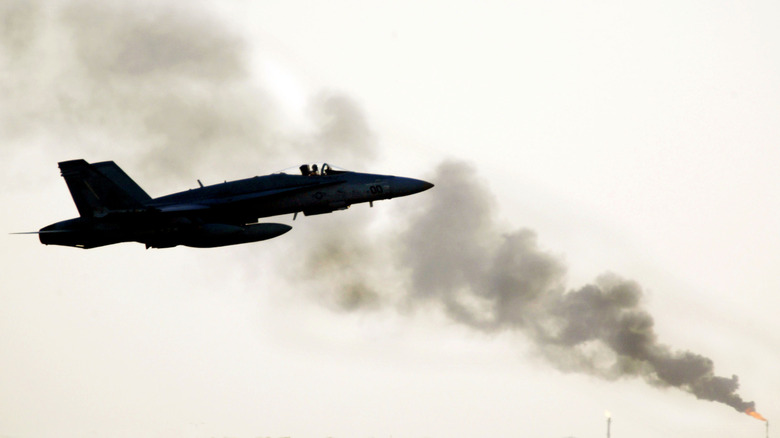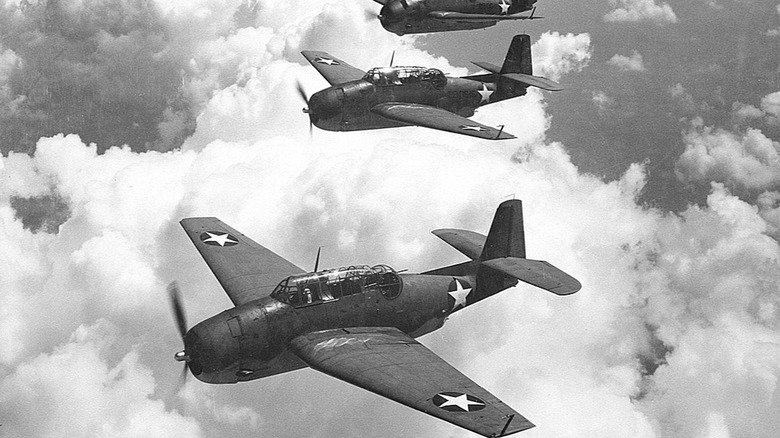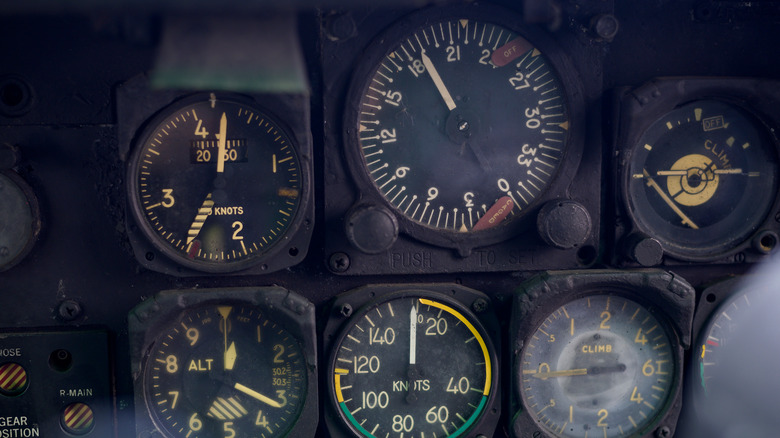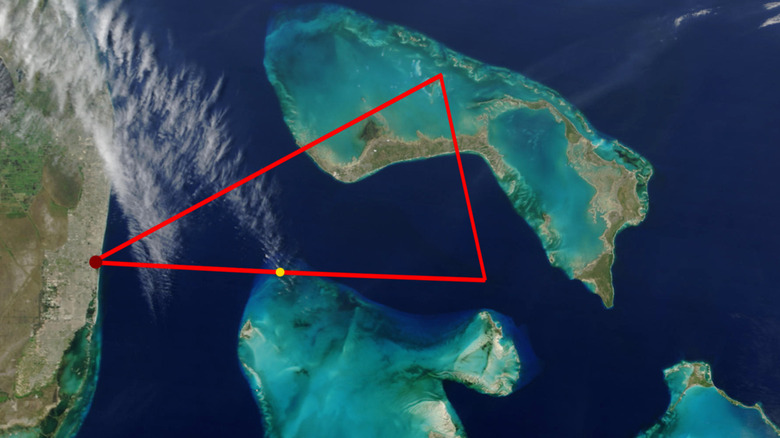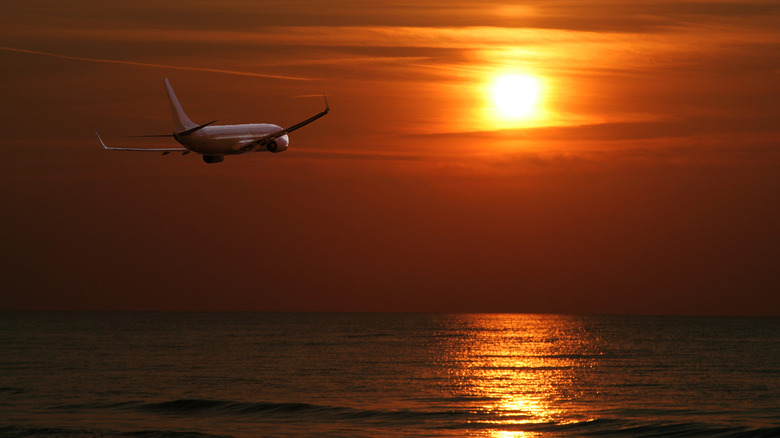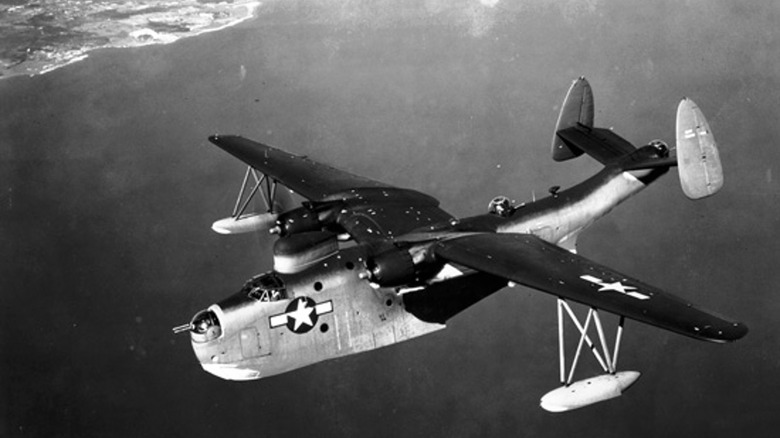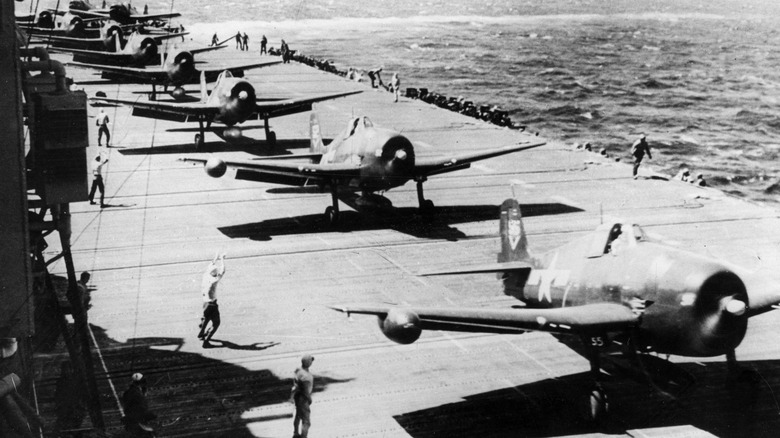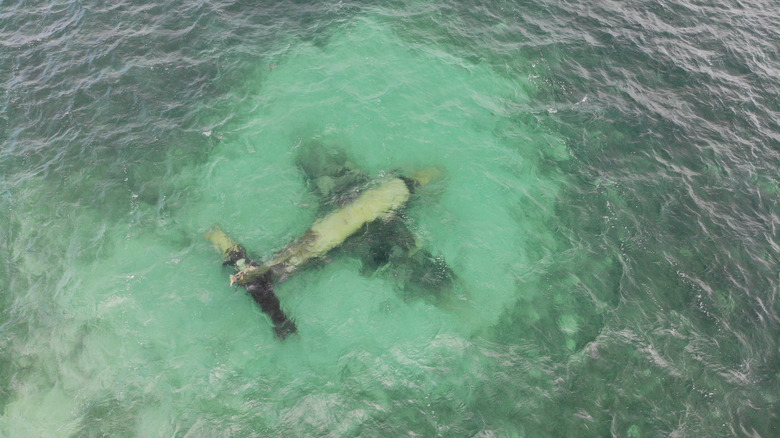Why The Disappearance Of Flight 19 Remains Unsolved
When you think of the Bermuda Triangle, images of ghostly ships, lost planes, and whole swaths of people vanishing into thin air are probably the first thoughts that fill your head. After all, this 500,000-square-mile section of the western North Atlantic Ocean between the coasts of Florida, Bermuda, and the Greater Antilles, also sometimes called the "Devil's Triangle," is thought to be plagued by dark and perhaps supernatural forces and that reputation didn't just arise out of nowhere, per the Richmond Times-Dispatch.
The Bermuda Triangle has a long history of travelers mysteriously going missing once they pass into that section of the ocean, with more than 70 airplanes and ships that are believed to have disappeared inside the triangle since the mid-19th century, so it is no wonder why it has attracted a reputation as a rather haunted place (via Britannica). One of the most infamous disappearances to have ever occurred in the Bermuda Triangle is the still-unexplained disappearance of Flight 19, which mysteriously vanished on December 5, 1945.
The flight began as a routine training exercise
The morning of December 5, a group of five TBM Avenger torpedo bombers, collectively known as "Flight 19," set off from the Naval Air Station in Ft. Lauderdale, Florida, led by the experienced pilot and combat veteran Lieutenant Charles C. Taylor, on a routine navigation and bombing training mission, according to History.
Comprised of fourteen airmen in total, most of whom had close to 300 hours of experience in their air, the group was tasked with flying due east from the Florida coast to Hen and Chickens Shoals in the Bahamas, over which they were to conduct bombing practice. From there, they were expected to fly north for close to eighty miles, passing over Grand Bahama Island before turning their planes southwest and heading back towards their base in Ft. Lauderdale. They were the 19th training squadron to complete this particular training assignment, called "Navigation Problem Number One," that day, and the whole flight was expected to take only three hours. But tragically, that turned out not to be the case.
Things began to take a turn for the worse about 90 minutes into the flight
Flight 19 took off in fairly average weather, with five-and-a-half hours worth of fuel onboard the aircraft, according to the USS Midway Museum. At first, the mission seemed to be going according to plan, with no apparent cause for worry. The bombers made it safely to Hen and Chickens Shoals, where they reportedly were able to successfully complete their bombing exercises. However, about ninety minutes into the assignment, when the bombers were flying north on the second leg of their flight, something either with the plane, or the crew, or both began to get screwy, according to the Naval Air Station Fort Lauderdale Museum.
Lieutenant Taylor appeared to become confused and disoriented, seemingly out of nowhere, saying that the Avengers' compasses had suddenly stopped working, which was an odd occurrence in and of itself. But now apparently lost, Lt. Taylor seemed to think that he was now flying over the Florida Keys, heading in the complete opposite direction of his intended destination, which was another exceptionally strange turn of events, particularly for a pilot with Taylor's experience.
Lt. Taylor became increasingly lost and disoriented
Lt. Taylor managed to make contact over the radio with another Navy pilot who was in the air, senior flight instructor Lt. Robert F. Cox. "Both my compasses are out and I'm trying to find Ft. Lauderdale, Florida. I'm over land, but it's broken. I'm sure I'm in the Keys, but I don't know how far down," Lt. Taylor reported over the radio to a senior flight instructor, via History. But that statement had to be incorrect. There was no way Taylor's plane, which had been in the Bahamas less than an hour before, could have made it all the way to the Florida Keys in such a short amount of time. Clearly, something was wrong, but no one could seem to get through to the increasingly more disoriented Lieutenant.
The other pilots, as well as Lt. Cox, repeatedly tried to guide him toward the Florida Mainland, but no one could convince him that they were not really flying over the Keys. Lt. Taylor was new to the Ft. Lauderdale area, so it was possible that he had simply become confused over the unfamiliar landmarks, but there seems to be no satisfying explanation as to why he refused to listen to reason from other experienced pilots.
Lt. Taylor refused aid from a fellow Navy pilot
Even more strangely, Lt. Taylor turned down an offer from Lt. Cox to fly out to meet them and guide Flight 19 back into the mainland, telling the instructor sometime around 4 p.m. that he now knew where he was and telling him "Don't come after me," according to the USS Midway Museum. However, by now it was clear that was not the case. Lt. Taylor appeared to be suffering some strange confusion over which direction they needed to fly home.
While it was routinely understood that lost planes flying over the Atlantic needed only to set their course west toward the setting sun to reach land, Taylor instead ignored the other pilots and twice directed the plane to fly northeast, seemingly believing that they were flying somewhere over the Gulf of Mexico and needed to head east to reach home. However, in reality, he was only taking his squadron farther out into the sea, as their fuel supplies dwindled perilously low.
The entire rescue crew disappeared into thin air
A little after 6 p.m., Lt. Cox lost all contact with Flight 19, and their radio transmissions faded into nothing but static, according to the Naval Air Station Fort Lauderdale Museum. With Flight 19 now presumably lost at sea, the Navy dispatched a rescue mission to try to find the crew. A pair of PBM Mariner flying boats were sent to search for the missing Flight 19 around 7:30 p.m., according to History. And that's where the story gets even eerier. Just 20 minutes after takeoff, the PBM Mariner rescue seaplane disappeared from the radar, never to be seen again.
It is believed that the plane, which was a model notorious for catching fire, exploded in midair due to a fuel leak, a theory which was further confirmed by eyewitness accounts of a nearby freighter, which claimed to have seen the flames, according to the USS Midway Museum. However, neither the debris of the seaplane, nor the remains of thirteen men onboard the rescue mission, were ever recovered.
The largest peacetime search party was organized to find Flight 19
In the following days, the Navy dispatched 248 planes and 18 surface craft to search for whatever might remain of Flight 19, in what was then the largest search and rescue mission ever dispatched during peacetime, according to the Naval Air Station Fort Lauderdale Museum.
The search crews covered over 200,000 square miles of the Atlantic Ocean and the Gulf of Mexico, as well as parts of the Florida mainland, in hopes of turning up some answers. The Coast Guard joined the search as well, and over the next few days, servicemen searched for "three days, six hours a day, they plowed up and down the whole coast of Florida, looking for wreckage but we never saw a thing," as Frank Dailey, a Naval Reserve Captain who was involved in the search, recalled. But no traces of any of the planes were ever found. Ultimately, according to Navy Lt. David White, "They just vanished. We had hundreds of planes out looking, and we searched over land and water for days, and nobody ever found the bodies or any debris" (via History).
No trace of Flight 19 has even been found
Eventually, the Navy was forced to attribute Flight 19's disappearance to "causes or reasons unknown," per History. In the subsequent years, there has certainly been no shortage of wild theories that have cropped up attempting to explain what really happened to the crew of Flight 19. Some believe that, especially given the notorious location of its disappearance over the Bermuda Triangle, something supernatural was the real reason why the flight got so turned around. Others theorize that a strange electromagnetic disturbance somehow disrupted the compasses and navigational tools onboard the aircraft, per the Naval Air Station Fort Lauderdale Museum.
And of course, no list of wild theories would be complete without at least a few people speculating that aliens were somehow involved. However, all the evidence only seems to indicate that the plane simply ran out of gas over the Atlantic, and the remains are still hidden somewhere in the bottom of the ocean floor. In total, 27 men lost their lives as a result of the ill-fated training exercise, and to this day, no one has been able to come up with a satisfactory explanation as to why Flight 19 went so tragically and mysteriously off course.
